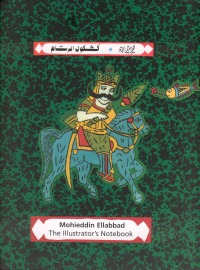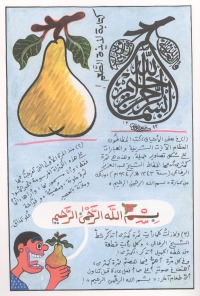| ________________
CM . . .
. Volume XII Number 13 . . . .March 3, 2006 
 |
The Illustrator’s Notebook.
Mohieddin Ellabbad. Translated by Sarah Quinn.
Toronto, ON: Groundwood Books/House of Anansi Press, 2006.
36 pp., cloth, $16.95.
ISBN 0-88899-700-0.
Subject Headings:
Ellabbad, Mohieddin—Notebooks, sketchbooks, etc.—Juvenile literature.
Ellabbad, Mohieddin-Childhod and youth—Juvenile literature.
Illustrators—Egypt—Biography—Juvenile literature.
Grades 1 and up / Ages 6 and up.
Review by Sylvia Pantaleo.
**** /4
Reviewed from prepublication copy. |
| |
|

excerpt:
When we grew up we learned a thing or two. For example, we discovered that a printing press is just a lifeless machine. It doesn’t create art. It just reproduces the images presented to it, whether they are beautiful or not. We learned that the true artist draws “what he likes to draw” and not “like a printing press.” It’s the other way around. A printing press will print what the artist has drawn. Without the artist it is nothing.
The flexibility of the picture book format has enabled Groundwood to authentically honour the creative work of Egyptian artist, Mohieddin Ellabbad. Groundwood has published The Illustrator’s Notebook as it appeared originally in Egypt. Hence, the picture book is read right to left, and, according to European North American practices, the front cover is where the back cover would normally be and vice versa. Readers are told, “This book opens on the other side,” and arrows direct their attention to the back/front of the book.
 Reproductions of pages from Ellabbad’s notebooks are featured on each numbered recto and verso. Each unique page has multiple layers of meaning. The pages in The Illustrator’s Notebook contain a variety of visual images including postcards, photographs, drawings, paintings and text written in Arabic. Appearing alongside each notebook page is the English translation of the Arabic text as well as a title for the page. Some of the page titles include “Souvenirs,” “First Impressions,” “How Should we Draw?” and “Some Room for the Reader.” Ellabbad’s words and images describe the cultural, historical and social multisensory inspirations for his art work. The text segments contain many provocative statements and thoughtful questions that encourage readers to think deeply about the issues that Ellabbad has explored through his visual and verbal texts. For example, when writing about “Discoveries,” he writes, “There are thousands of things around us that we don’t even see, because we don’t take time to look at them. For example, have you ever looked at the beautiful landscape that is drawn right in the palm of your hand?” Essentially Ellabbad encourages readers to “see” the world and find meaning and stimulation in commonplace visual items and phenomena. Reproductions of pages from Ellabbad’s notebooks are featured on each numbered recto and verso. Each unique page has multiple layers of meaning. The pages in The Illustrator’s Notebook contain a variety of visual images including postcards, photographs, drawings, paintings and text written in Arabic. Appearing alongside each notebook page is the English translation of the Arabic text as well as a title for the page. Some of the page titles include “Souvenirs,” “First Impressions,” “How Should we Draw?” and “Some Room for the Reader.” Ellabbad’s words and images describe the cultural, historical and social multisensory inspirations for his art work. The text segments contain many provocative statements and thoughtful questions that encourage readers to think deeply about the issues that Ellabbad has explored through his visual and verbal texts. For example, when writing about “Discoveries,” he writes, “There are thousands of things around us that we don’t even see, because we don’t take time to look at them. For example, have you ever looked at the beautiful landscape that is drawn right in the palm of your hand?” Essentially Ellabbad encourages readers to “see” the world and find meaning and stimulation in commonplace visual items and phenomena.
Mohieddin Ellabbad was born in Cairo, and, at the age of 17, he joined the Faculty of Fine Arts in the Zamalek District of Cairo. As well as an illustrator, he draws caricatures and has worked as an author, art director, and designer. Both national and international newspapers and magazines, universities and organizations have sought Ellabbad’s creative work and expertise. His books have received many awards, and The Illustrator’s Notebook, previously published in Arabic, French and German, has won three awards.
Highly Recommended.
Sylvia Pantaleo teaches language arts courses in the Faculty of Education at the University of Victoria in Victoria, BC.

To comment
on this title or this review, send mail to cm@umanitoba.ca.
Copyright © the Manitoba Library Association. Reproduction for personal
use is permitted only if this copyright notice is maintained. Any
other reproduction is prohibited without permission.
NEXT REVIEW |
TABLE OF CONTENTS FOR THIS ISSUE
- March 3, 2006.
AUTHORS |
TITLES |
MEDIA REVIEWS |
PROFILES |
BACK ISSUES |
SEARCH |
CMARCHIVE |
HOME |

 Reproductions of pages from Ellabbad’s notebooks are featured on each numbered recto and verso. Each unique page has multiple layers of meaning. The pages in The Illustrator’s Notebook contain a variety of visual images including postcards, photographs, drawings, paintings and text written in Arabic. Appearing alongside each notebook page is the English translation of the Arabic text as well as a title for the page. Some of the page titles include “Souvenirs,” “First Impressions,” “How Should we Draw?” and “Some Room for the Reader.” Ellabbad’s words and images describe the cultural, historical and social multisensory inspirations for his art work. The text segments contain many provocative statements and thoughtful questions that encourage readers to think deeply about the issues that Ellabbad has explored through his visual and verbal texts. For example, when writing about “Discoveries,” he writes, “There are thousands of things around us that we don’t even see, because we don’t take time to look at them. For example, have you ever looked at the beautiful landscape that is drawn right in the palm of your hand?” Essentially Ellabbad encourages readers to “see” the world and find meaning and stimulation in commonplace visual items and phenomena.
Reproductions of pages from Ellabbad’s notebooks are featured on each numbered recto and verso. Each unique page has multiple layers of meaning. The pages in The Illustrator’s Notebook contain a variety of visual images including postcards, photographs, drawings, paintings and text written in Arabic. Appearing alongside each notebook page is the English translation of the Arabic text as well as a title for the page. Some of the page titles include “Souvenirs,” “First Impressions,” “How Should we Draw?” and “Some Room for the Reader.” Ellabbad’s words and images describe the cultural, historical and social multisensory inspirations for his art work. The text segments contain many provocative statements and thoughtful questions that encourage readers to think deeply about the issues that Ellabbad has explored through his visual and verbal texts. For example, when writing about “Discoveries,” he writes, “There are thousands of things around us that we don’t even see, because we don’t take time to look at them. For example, have you ever looked at the beautiful landscape that is drawn right in the palm of your hand?” Essentially Ellabbad encourages readers to “see” the world and find meaning and stimulation in commonplace visual items and phenomena.